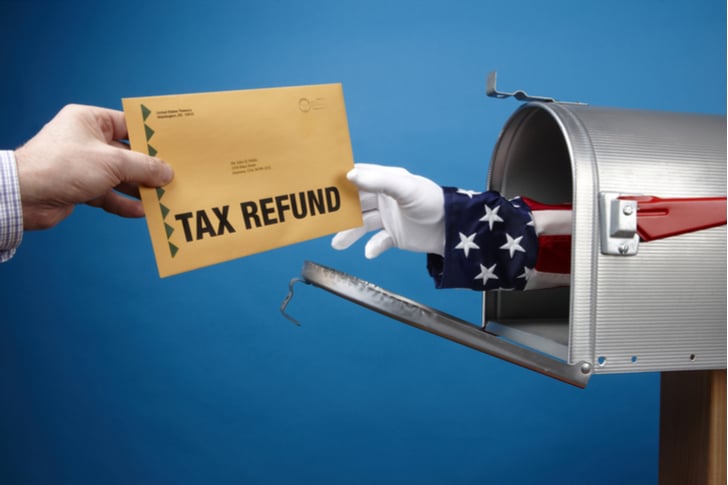
Source: Shutterstock
Editorial Note: InvestorPlace Beacon independently determines what we cover and recommend. We earn a commission from affiliate partners on many offers and links. However, these commissions do not affect our editors' opinions or evaluations. Click here to read our full advertiser disclosure.
Plan ahead for this year’s tax season by considering smart ways to use your refund. There are many different investment and savings vehicles to consider, and we suggest several with varying returns and liquidity. You can also consider eliminating any outstanding debt.
Why You Should Think Strategically About Using Your Tax Refund
If you receive a tax refund this year, it may be tempting to spend it on new shoes, a last-minute vacation or a night out with friends. But thinking about how to strategically use your refund could pay off in the long run.
While throwing the extra cash into a checking or savings account may help your future self more than spending it on an immediate splurge, where you store that money matters too. Checking accounts don’t usually earn interest and traditional saving accounts currently earn just 0.47% on average.
If you want to make the most of your refund, consider one of the following three options:
- Save in a high-yield savings account or CD
- Invest for your future
- Pay off your debt
Save Your Tax Refund in a High-Yield Savings Account or CD
Placing your tax refund in a high-yield savings account allows you to bulk up your savings for your emergency fund and short-term goals while hedging against inflation. Many accounts offer 5% (annual percentage yield) APY or higher, allow you to access your money whenever you need it and are insured by the Federal Deposit Insurance Corporation (FDIC) up to $250,000 per account.
However, it’s important to note that high-yield saving account rates aren’t set, so those near-5% yields likely won’t last forever.
Even contributing just a portion of your refund can bring decent gains. For example, if you contribute $1,000 of your tax return to a high-yield savings account with a 5% APY, you’d earn $50 in interest after one year. The same deposit amount in a traditional savings account with a 0.47% APY would only earn you $4.70 in earnings after one year.
Putting your tax refund into CDs is another way to earn interest on your savings that’s higher than the national average. Many CDs offer APYs above 5% and are also FDIC-insured.
Unlike a high-yield savings account, a CD’s rate is fixed, meaning you can lock in a high rate for the CD’s entire term, which is how long your funds are required to stay in the CD. If you’re comfortable locking away your funds for a specific period of time with a fixed rate, a CD could be a good option for you.
Invest Your Tax Refund
If you’re looking for higher potential returns than you’ll see with a savings instrument, you can invest some or all of your tax return. You can do this by opening a taxable brokerage account or retirement account — like an individual retirement account (IRA) or a Roth IRA — and buying financial assets like stocks, mutual funds and exchange-traded funds (ETFs).
Some online brokers offer commission-free trades, but there are still costs to consider when choosing a platform, like management fees. Investments like stocks, mutual funds and ETFs aren’t insured by the FDIC, but the Securities Investor Protection Corporation (SIPC) protects your money up to $500,000 per account including $250,000 in cash in the case that a brokerage firm collapses.
Investing your money does give it the potential to earn higher returns than it would sitting in a savings account. The S&P 500 — an index commonly used as a benchmark for the overall U.S. stock market — has historically earned a 10% average annual return. In addition to benefiting from increasing market prices, your investments may also earn dividends.
Consider speaking to a financial advisor before investing, and make sure to research any potential fees or minimum investment requirements.
Pay Off Debt
Paying off your debt is another way to take advantage of any extra money coming your way in the form of a tax refund, and doing so can save you from making interest payments for longer than necessary.
Financial advisors typically recommend focusing on paying off your debt with the highest interest first, which is often credit card debt. The average credit card interest rate is 24.61%, according to a LendingTree study. Even a small amount of credit card debt can cost you hundreds of dollars.
Say you owe $2,000 and plan to pay $100 a month. With a rate of 24.61%, you’ll pay $540 in interest and it will take 26 months to pay off. Instead, you could use your tax refund to pay off all or a part of your debt.
Paying off other types of debt with your refund — like auto or student loans — may also make sense, depending on your situation.
Sources:
Schulz, M. (2024, February 15). Average Credit Card Interest Rate in America Today. Retrieved from https://www.lendingtree.com/credit-cards/average-credit-card-interest-rate-in-america/
Federal Deposit Insurance Corporation. (2024, January 16). National Rates and Rate Caps. Retrieved from https://www.fdic.gov/resources/bankers/national-rates/index.html



